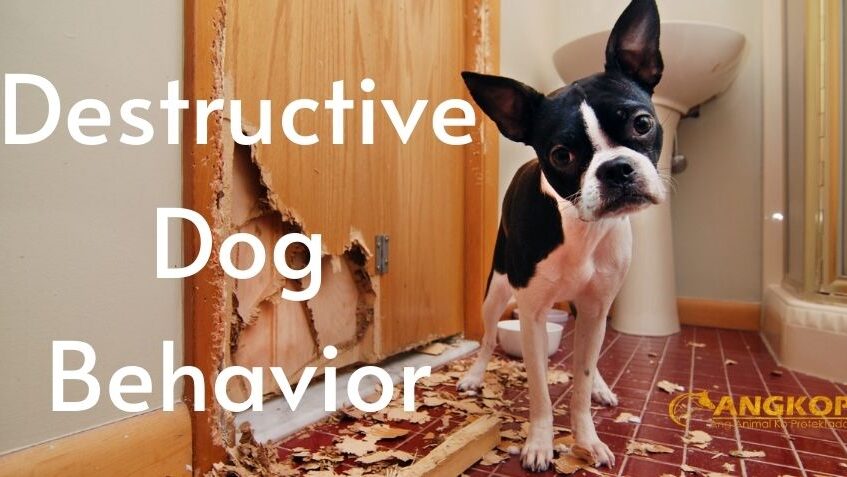Destructive Dog Behavior
- Behavior that causes damage to an owner’s home or belongings.
- Primary destructive behavior is normal behavior that includes exploratory and play-based behavior.
- Secondary destructive behavior is a clinical sign of another behavior condition.
SYSTEMS AFFECTED
- Gastrointestinal—damage to teeth; vomiting and diarrhea, obstruction if ingested.
- Musculoskeletal—traumatic damage caused by scratching or chewing.
- Ingestion of toxic material could affect any organ system.
SIGNALMENT
- Any breed or gender.
- Primary destructive behavior is seen in dogs < 1 year of age.
- Secondary destructive behavior can be seen at any age.
SIGNS
Primary Destructive Behavior
- Initially occurs in the presence or absence of the owner.
- Not preceded by a specific environmental trigger.
- Absence of anxiety or aggression.
Secondary Destructive Behavior
- Attention-seeking behavior—destructive behavior in the presence of the owner.
- Separation-related anxiety—destructive behavior consistently occurs in the absence of the owner, and rarely in the presence of the owner; target items may include personal belongings, furniture, or points of egress.
- Storm phobia, noise phobia—destructive behavior and/or anxiety-related behavior in response to stimuli whether or not the owner is present. Intensity may be greater during the owner’s absence.
- Territorial aggression—arousal is observed in presence of the owner; destructive behavior is intermittent based on the presence of triggers; window frames and doorways are damaged.
CAUSES & RISK FACTORS
- Primary destructive behavior represents normal behavior; inadequate supervision and insufficient access to appropriate outlets may affect destructive behavior.
- Owner scolding, leading to either fear or attention-seeking.
- Risk factors for anxiety-based conditions are not clearly identified.
- Territorial aggression may have genetic and learned components.
DIAGNOSIS
DIFFERENTIAL DIAGNOSIS
- Identify pathologic conditions.
- If pica accompanies destructive chewing—rule out conditions affecting digestion, absorption, polyphagia, and appetite, including recent diet change.
- If licking surfaces, rule out upper GI disease.
- For sudden onset in a mature pet with no notable environmental changes—rule out medical conditions.
- For age-related onset, rule out cognitive dysfunction syndrome.
CBC/BIOCHEMISTRY/URINALYSIS
Usually normal
OTHER LABORATORY TESTS
As indicated to rule out medical conditions.
IMAGING
May be indicated if there is a sudden onset in a mature pet.
DIAGNOSTIC PROCEDURES
Physical examination with attention to the GI tract.
TREATMENT
Treat the underlying disease.
PRIMARY DESTRUCTIVE BEHAVIOR
- Supervise, confine or dog proof until appropriate behavior has been established.
- Assure access to acceptable chew toys.
- Reward appropriate behavior—select toys that dispense food or can be stuffed with food.
- Interrupt inappropriate behavior, apply non-toxic bitter-tasting products, then offer appropriate activity.
- Provide adequate interactive play.
- Use caution in applying any form of punishment. Any correction must be applied humanely, without causing pain or fear that could trigger anxiety or aggression.
SECONDARY DESTRUCTIVE BEHAVIOR
- Attention-seeking—provide owner-initiated interactions; teach sit for all interactions.
- Compulsive disorder—reduce sources of anxiety; offer interactive play and appropriate chew items; prevent access to target items.
- Separation-related anxiety—behavior modification; punishment is contraindicated.
- Noise phobia—behavior modification; reduce access to triggers.
- Territorial aggression—behavior modification, prevents access to doors and windows.
MISCELLANEOUS
AGE-RELATED FACTORS
Age of onset may aid in diagnosis.
PREGNANCY/FERTILITY/BREEDING
Periparturient destructive behavior (nesting).
ABBREVIATIONS
SSRI = selective serotonin reuptake inhibitor
TCA = tricyclic antidepressant
Visit your veterinarian as early recognition, diagnosis, and treatment are essential.
You may also visit – https://www.facebook.com/angkopparasahayop




